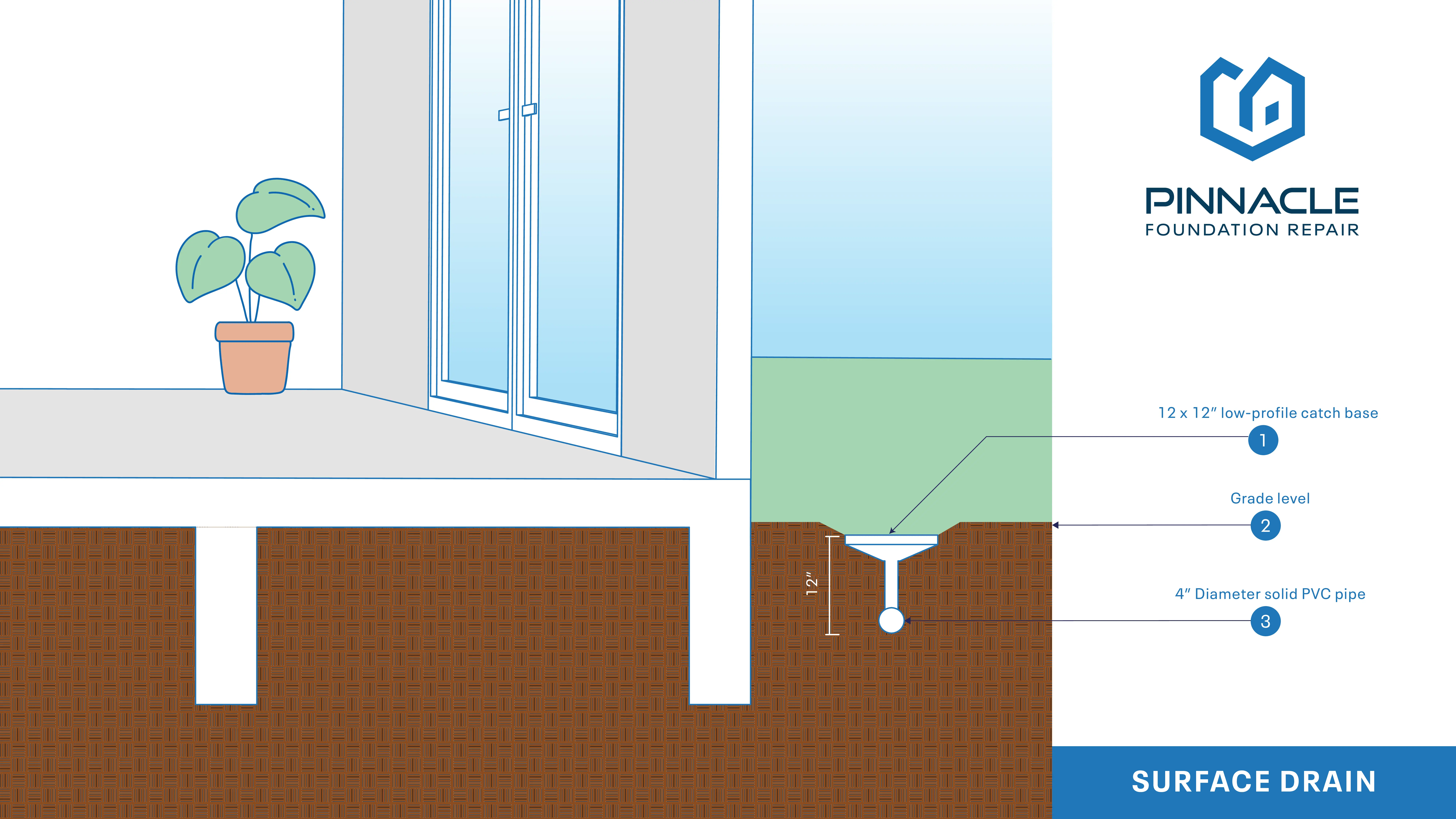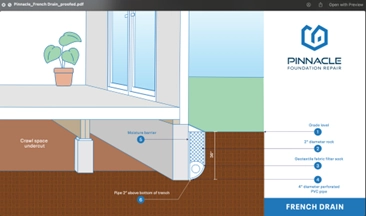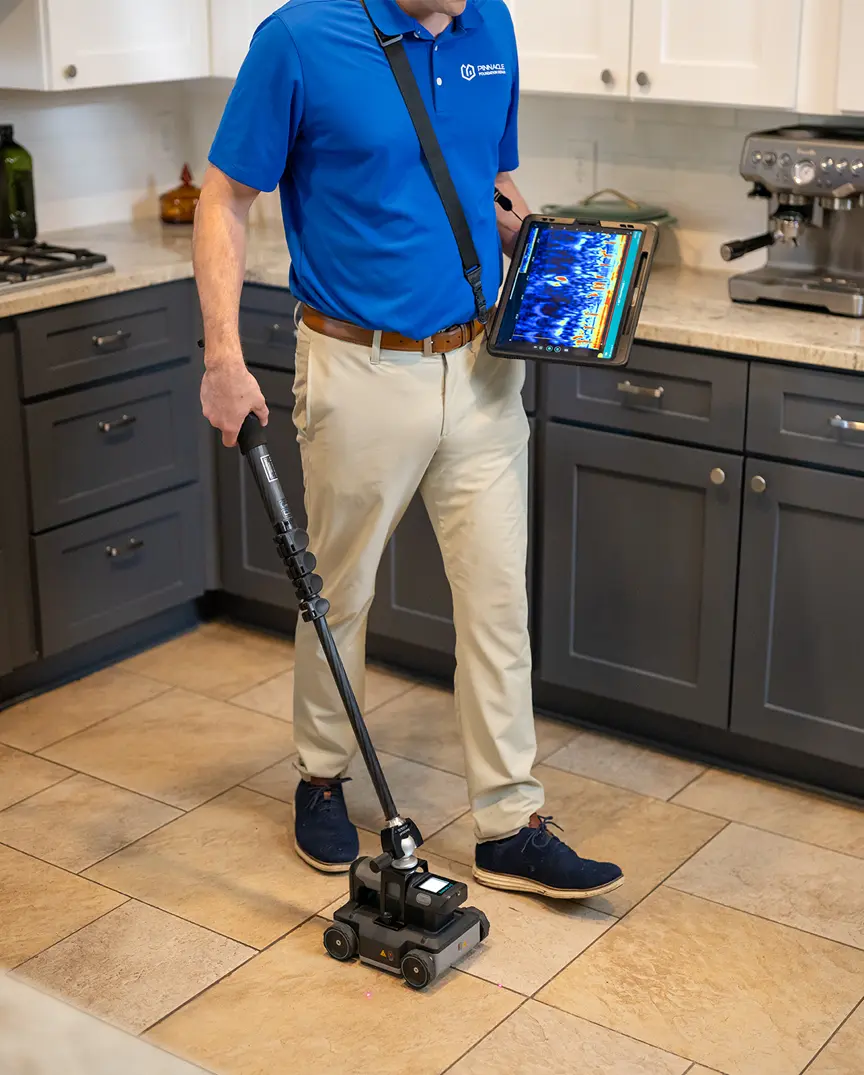Foundation Drainage Correction
Protecting Your Home from Water Damage
5-YEAR WARRANTY
Contact Us
If you have any query about our service please contact with us
Foundation issues can lead to costly repairs, but sometimes, the solution doesn’t have to break the bank. By addressing drainage problems upfront, you can prevent further damage and safeguard your home. We specialize in installing effective drainage systems that keep your foundation dry and secure. Say goodbye to damp, mold, and water-affected foundation damage with Pinnacle’s foundation drainage solutions!
Why is proper foundation drainage important?
Ensuring your foundation has proper drainage isn’t just a good idea – it’s essential for keeping your home safe and secure. By effectively managing both surface and subsurface water, a reliable drainage system prevents water from pooling around your foundation. This proactive approach helps fend off issues like moisture infiltration, mold growth, and potential damage to your home’s foundation.
Plus, with water directed away from your foundation, you’ll avoid problems like soil erosion and the buildup of hydrostatic pressure, which can lead to costly repairs down the road. So, investing in good drainage isn’t just about protecting your property – it’s about saving yourself from headaches and expenses in the long run.
Surface Drains: Keeping Surface Water at Bay

Pinnacle’s surface drains are designed to redirect water away from your home’s foundation. A surface drain features a 12 inch by 12 inch low-profile catch basin that is installed slightly below grade level. These basins are then connected to 4 inch PVC lines approximately a foot beneath the ground’s surface.
The grading is slightly sloped to encourage water running, which avoids water pooling next to your foundation. Gutter downspouts can also be tied into the drain system to allow for the runoff of rainwater.
By preventing water buildup around the foundation, surface drains offer a simple and stress-free solution to protect your home.
French Drains: Tackling Subsurface Water Issues

If you live in an area that has a low surface area or is at a higher risk of flooding, a French drain may be necessary for foundation protection. Despite their seemingly simple appearance – just gravel or rocks covering a pipe – French drains are sophisticated, multi-layered systems designed to efficiently manage subsurface water. Installed at a slight 1% slope and typically starting at a depth of 36 inches, French drains ensure water flows away from your foundation, even during heavy rainfall. The drain itself consists of a perforated 4 inch PVC line, often lined with a geotextile fabric filter in areas with silty or sandy soil.
Maintaining the proper angle is key to ensuring water flows smoothly, and regular monitoring is necessary to prevent clogs and ensure optimal performance. French drains channel water downhill, either releasing it at a designated point or connecting to another underground drainage system. While their installation may seem straightforward, careful planning and execution are crucial to prevent issues like clogging and inefficient water flow.
In some cases, installing a French drain also requires a sump pump to discharge water. (A sump pump is a mechanical system designed to catch excess water in a basin and then pump it out from beneath your home). This pump needs its dedicated electrical circuit, which adds slightly to the overall cost of French drain installation.
Despite the initial investment, French drains offer outstanding protection for your foundation, keeping it dry and secure year-round.
Considerations and FREE Consultations
Before committing to any foundation repair method, it’s essential to assess your drainage needs. Water damage can be a complex and expensive issue to troubleshoot, and consulting with professionals (like the radically honest team at Pinnacle) is crucial for helping you determine the right solution for your home.
Whether you’re dealing with surface water or subsurface issues, investing in a reliable drainage system can be a cost-effective way to safeguard your home’s foundation. Don’t overlook the importance of proper drainage – take proactive steps to protect your investment and ensure your home’s long-term stability!
Choosing Your Foundation Repair Solution
Pinnacle’s mud jacking service offers a swift and cost-effective solution to rectify uneven foundations and address floating slabs. However, one thing to point out is that the long-term success of this method relies on the quality of the existing plumbing and drainage systems surrounding the structure – if the soil expands or contracts after repairs, your structure may still experience movement, impacting the effectiveness of mud jacking. In these cases, we will diagnose the issue and suggest a more permanent solution.
It’s also important to note that even the best mud jacking repair won’t miraculously repair concrete that’s already deteriorated or severely crumbled. It’s only effective for concrete that’s still structurally sound, but has become uneven due to settling or uneven pressure from above.
If your slab needs a helping hand, mud jacking repairs can be a surprisingly affordable alternative to extensive concrete replacement, requiring less time and resources. Compared to replacing concrete slabs entirely, mud jacking is quicker and significantly more budget-friendly. While the overall cost may vary slightly depending on the specific needs and condition of the slab, our team at Pinnacle Foundation Repair prioritizes honesty. We’ll work with you to develop a cost-effective solution that meets your budget and delivers lasting results.
Radically Honest and Transparent
Around here, we’re always on the level. We take the time to explain problems and possible drainage solutions in plain language, walk you through the process, and answer all your questions before, during and after the project. To make communication even easier, your home evaluator is also your main point of contact throughout. Radically simple? You bet.
At Pinnacle Foundation Repair, we are committed to providing not just repairs, but lasting stability for your home or business. We also stand by our work with a radical commitment: a 5-year warranty on all our foundation drainage systems.
Contact us today for a FREE consultation and discover why our foundation drainage methods stand as a testament to our radical reliability and dependability in foundation repair.
Frequently Asked Questions
Why is proper foundation drainage important?
Proper drainage keeps water from pooling around your foundation, which helps prevent moisture infiltration, mold growth, and expensive foundation damage.
Can poor drainage really affect my foundation?
Yes, poor drainage can lead to soil erosion, hydrostatic pressure, and foundation damage, making a reliable drainage system essential for your home’s stability.
What types of drainage systems do you offer?
We offer surface drains and French drains. Surface drains redirect water away from your foundation, while French drains manage subsurface water to keep your foundation dry and secure.
How does a French drain work to protect my foundation?
French drains handle subsurface water by channeling it away from your foundation through a perforated pipe, preventing water buildup and soil erosion.
When should I consider installing a French drain?
If your home is prone to flooding or has low surface areas, a French drain can effectively manage excess water and protect your foundation from subsurface moisture.
What maintenance does a French drain require?
Regular monitoring is necessary to prevent clogs and ensure optimal performance. Keeping the slope clear and checking for blockages will maintain its efficiency.
What is a surface drain, and how does it work?
A surface drain collects water at ground level and directs it away from your foundation using a catch basin connected to underground PVC pipes, preventing water buildup.
Can a drainage system help with existing foundation problems?
Yes, fixing drainage issues can prevent more damage and can be part of a broader solution to existing foundation problems.
What warranty do you offer on your drainage systems?
We stand by our work with a 5-year warranty on all our foundation drainage systems, ensuring long-term protection from foundation water damage for your home.
Do you offer consultations for drainage solutions?

Schedule a FREE foundation evaluation
Don t wait till the cracks in the walls or the sticking doors become worse. Let us inspect your foundation free of charge, determine the cause of your problems and, if you have a foundation issue, give you a fair estimate. 1 out of 3 evaluations we conduct reveal no foundation issues
or call this number
